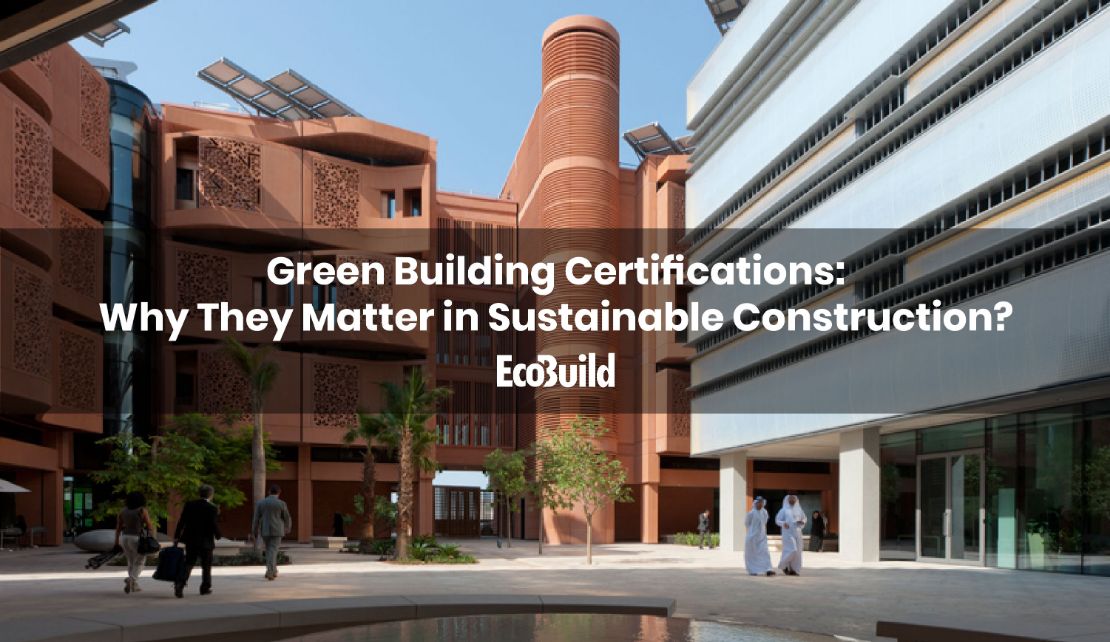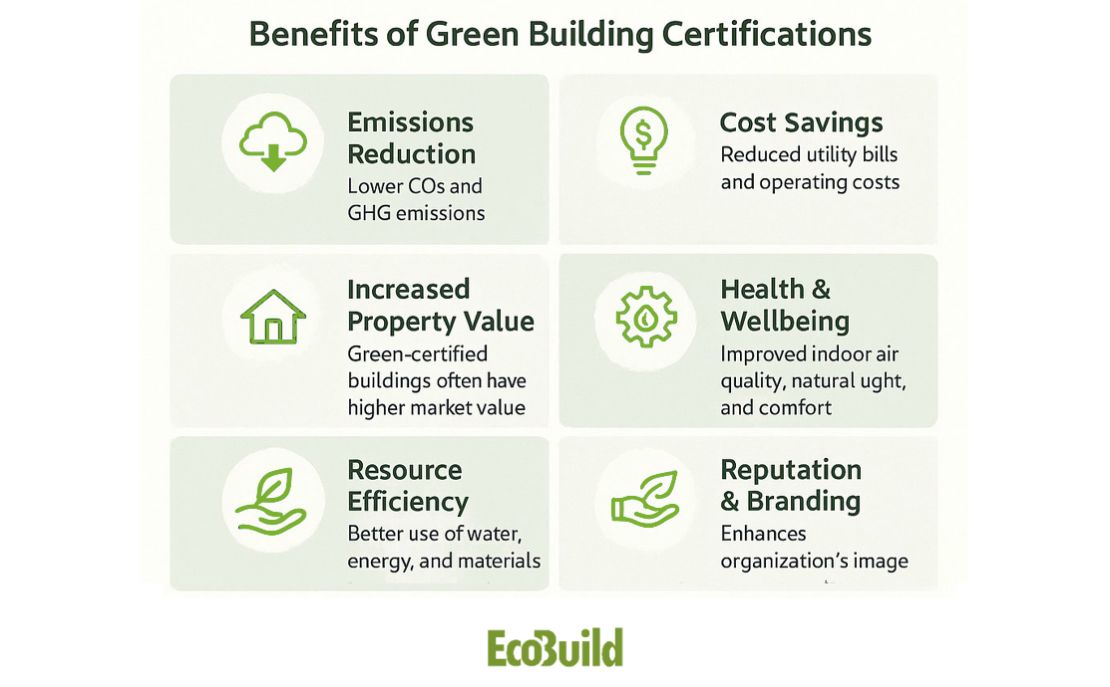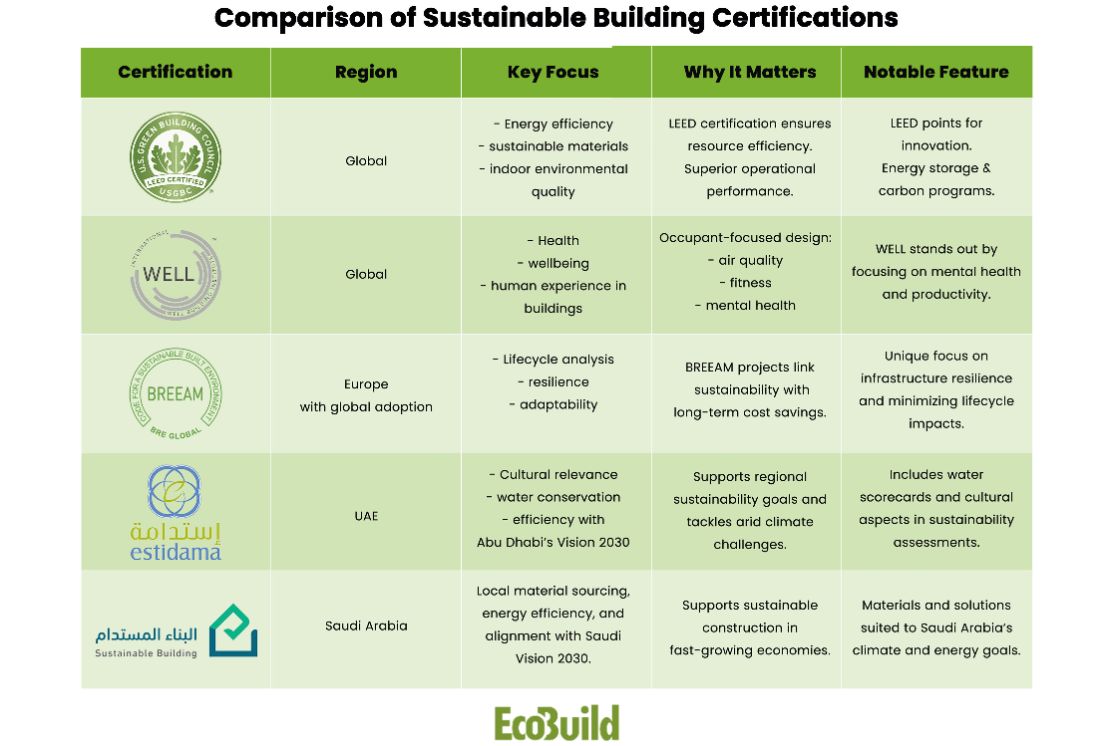
Green Building Certifications: Why They Matter in Sustainable Construction?
Insight Apr 21, 2025
Introduction: Building a Greener Future with Certifications
As the world grapples with the challenges of climate change, urbanization, and resource depletion, the construction industry has a critical role to play in shaping a sustainable future. Green building certifications such as LEED, WELL, BREEAM, ESTIDAMA, and MOSTADAM serve as benchmarks for sustainable design, construction, and operation, ensuring buildings meet rigorous environmental and social standards.
Certifications are more than accolades—they provide a comprehensive framework for reducing environmental impact, enhancing occupant wellbeing, and driving economic value.
At ECOBUILD, we specialize in navigating these certifications to create high-performance buildings that stand the test of time. Let’s dive deeper into the significance of these certifications and their transformative impact on sustainable construction.
WHAT DO GREEN BUILDING CERTIFICATIONS MEASURE?
Green building certifications evaluate buildings against specific sustainability criteria across various stages of their lifecycle. Here are some key performance areas:
- Energy Efficiency: Minimizing energy consumption through efficient systems, renewable energy integration, and smart technologies.
- Water Management: Reducing water use through efficient fixtures, rainwater harvesting, and greywater recycling.
- Material Use: Prioritizing sustainable, low-carbon, and locally sourced materials.
- 4. Indoor Environmental Quality (IEQ): Ensuring healthy indoor air, natural lighting, and thermal comfort for occupants.
- Waste Management: Diverting construction and operational waste from landfills through reuse and recycling.
- Resilience: Designing buildings to adapt to climate challenges, ensuring long-term sustainability.
THE VALUE OF GREEN BUILDING CERTIFICATIONS
Certified buildings are designed to reduce their carbon footprint by minimizing energy use, water consumption, and waste.
- Example: LEED-certified buildings use 25% less energy and generate 34% lower CO₂ emissions compared to non-certified buildings.
Certifications like WELL focus on the health and comfort of occupants, addressing air quality, lighting, and biophilic design.
- Stat: WELL-certified spaces lead to 10-15% increases in productivity and better overall occupant satisfaction.
Green certifications add significant value to properties by reducing operating costs, increasing asset value, and attracting tenants or buyers.
- Fact: Green buildings save 8-10% in operating costs within their first year of certification.
In a competitive market, certifications like LEED, BREEAM, and ESTIDAMA signal a commitment to sustainability, helping attract investors, tenants, and stakeholders.
Certifications often align with governmental sustainability targets, unlocking incentives like tax breaks, expedited permits, and grants.
- Example: ESTIDAMA’s Pearl Rating is mandatory for government buildings in Abu Dhabi, aligning with the UAE’s Net Zero goals.

DEEP DIVE INTO KEY CERTIFICATIONS
- Region: Global.
- Key Focus: Energy efficiency, sustainable materials, and indoor environmental quality.
- Why It Matters: LEED-certified buildings demonstrate superior resource efficiency and operational performance.
- Notable Feature: LEED allows points for innovations such as renewable energy storage and carbon offset programs.
- Region: Global.
- Key Focus: Health, wellbeing, and human experience in buildings.
- Why It Matters: Focuses on occupant-centric design, such as air quality, fitness opportunities, and mental health.
- Notable Feature: WELL’s emphasis on mental health and productivity through design sets it apart from other certifications.
- Region: Europe, with global adoption.
- Key Focus: Lifecycle analysis, resilience, and adaptability.
- Why It Matters: BREEAM-certified projects balance environmental sustainability with long-term cost efficiency.
- Notable Feature: A unique emphasis on infrastructure resilience and reducing lifecycle impacts.
- Region: UAE.
- Key Focus: Cultural relevance, water conservation, and resource efficiency in alignment with Abu Dhabi’s Vision 2030.
- Why It Matters: Supports region-specific sustainability goals while addressing arid climate challenges.
- Notable Feature: Incorporates water scorecards and cultural aspects into sustainability assessments.
- Region: Saudi Arabia.
- Key Focus: Local material sourcing, energy efficiency, and alignment with Saudi Vision 2030.
- Why It Matters: Drives the adoption of sustainable construction practices in one of the world’s fastest-growing economies.
- Notable Feature: Prioritizes materials and solutions suited to Saudi Arabia’s climate and energy goals.

ECOBUILD’s ROLE IN ACHIEVING CERTIFICATIONS
Achieving green building certifications requires expertise in planning, implementation, and compliance. ECOBUILD provides:
- Custom Certification Strategies: Tailoring certification pathways based on project needs and goals.
- Performance Optimization: Integrating energy-efficient systems, sustainable materials, and renewable energy.
- Lifecycle Assessments: Using Whole Life Carbon Analysis to identify and reduce emissions at every stage.
- Collaboration with Experts: Partnering with clients, architects, and engineers to meet certification standards efficiently.
CASE STUDY: NET ZERO PROJECT ACHIEVING LEED AND WELL CERTIFICATIONS
Project Name: Masdar Net Zero Mosque
Certifications Achieved: LEED Platinum, WELL Gold.
Key Features:
- Rooftop solar panels generating 50% of energy needs.
- Energy-efficient HVAC systems reducing operational energy by 40%.
- Biophilic design elements, including green walls and daylight optimization, enhancing occupant health.
- Reduced operational emissions by 45%.
- Increased tenant satisfaction by 25%.
Conclusion: A Pathway to Sustainable Construction
Green building certifications provide a roadmap for creating buildings that are not only efficient and resilient but also healthier and more valuable. By aligning with global and regional standards like LEED, WELL, BREEAM, ESTIDAMA, and MOSTADAM, developers can lead the way in sustainability while achieving long-term success.
💡 Let’s build smarter, greener spaces together. Contact ECOBUILD today to start your journey toward certification.
